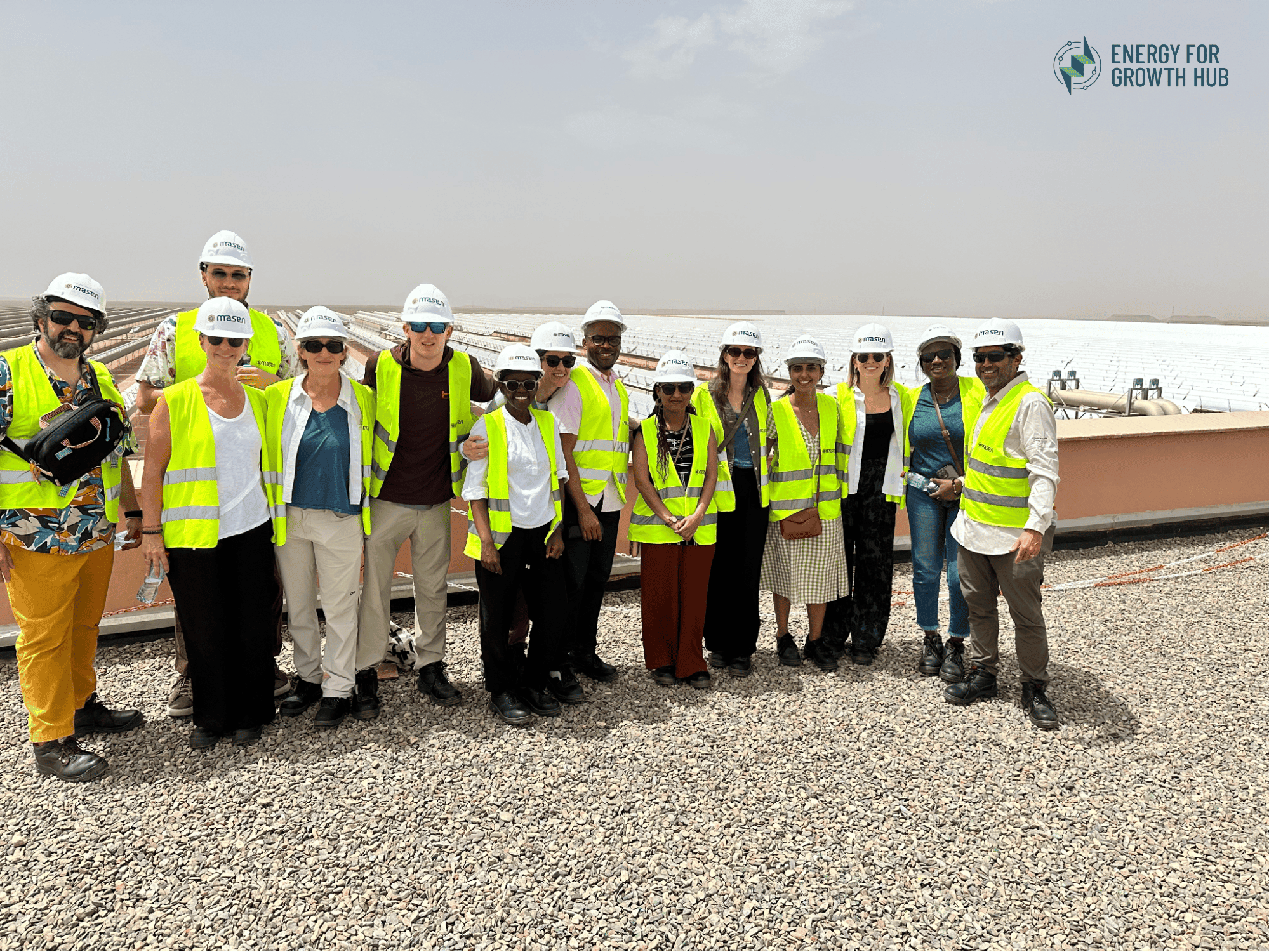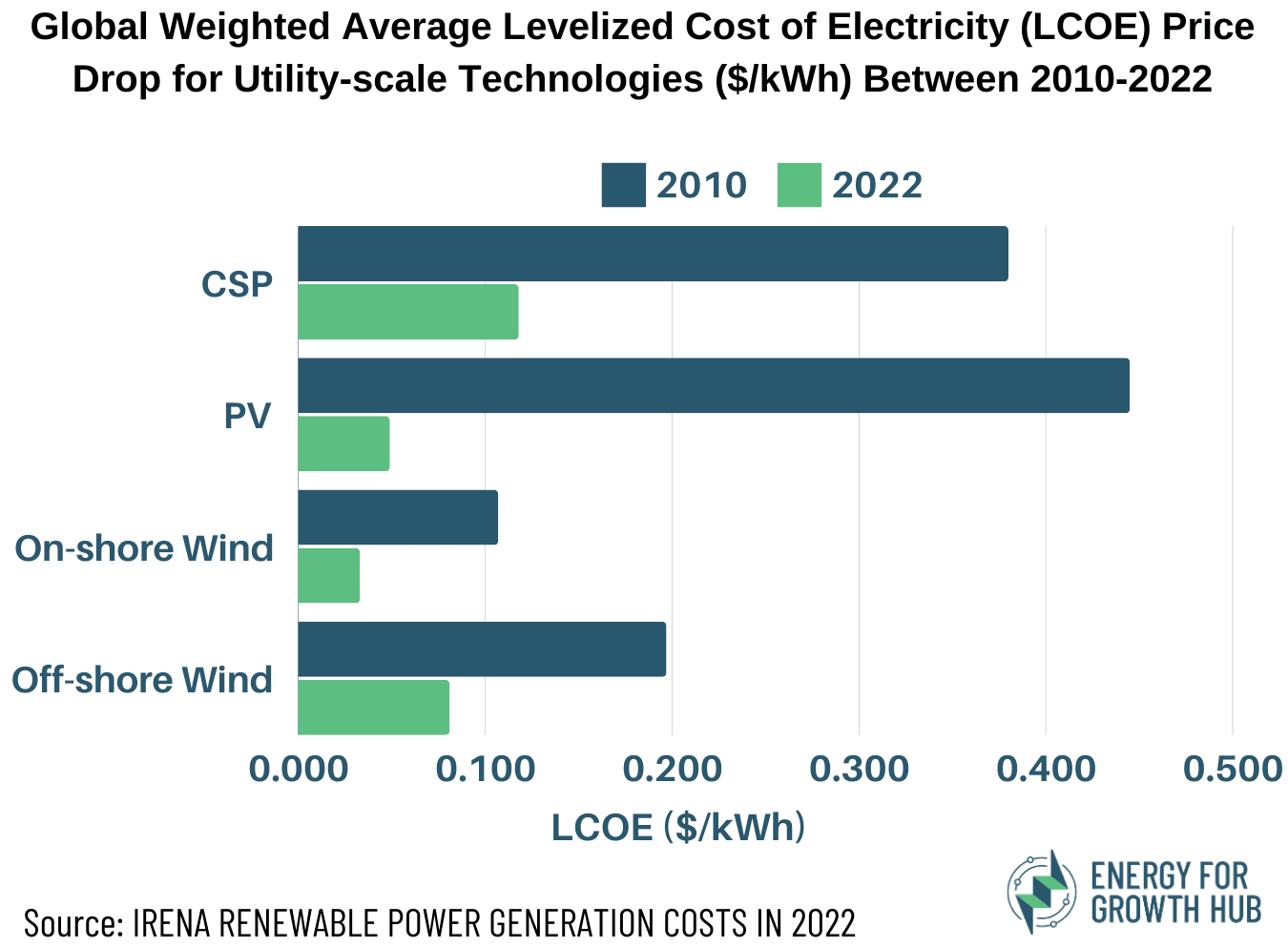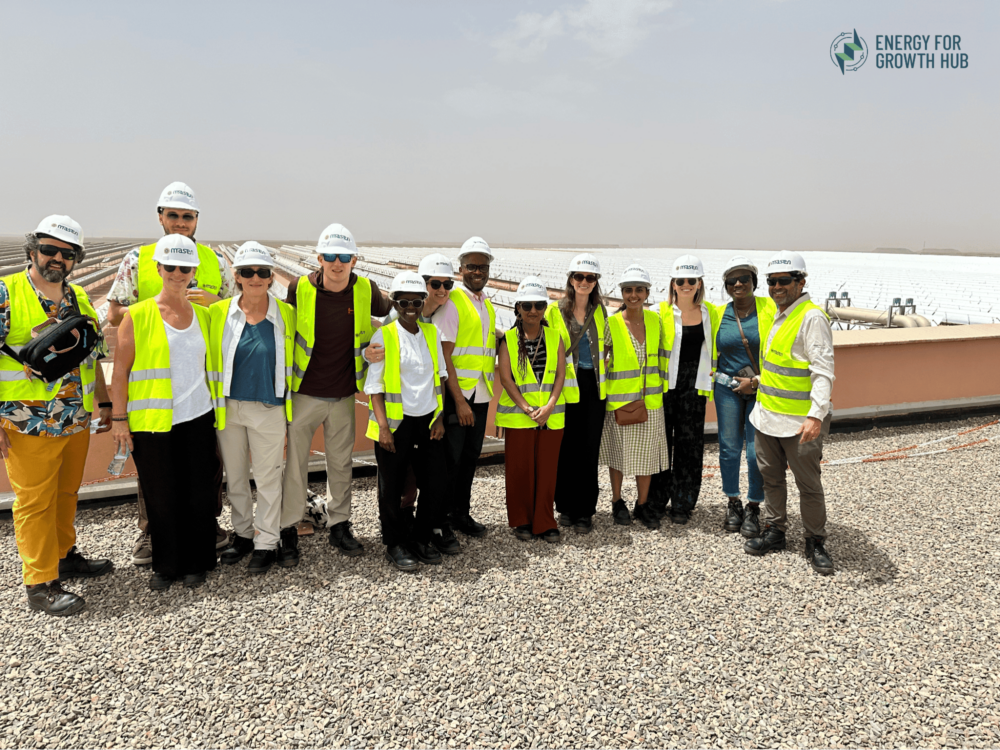Last month, our team visited the world’s largest concentrated solar power (CSP) project in Ouarzazate, Morocco. If you’re an energy tech nerd like me, this place has everything — heat exchanging liquids, steam turbines, molten salt storage systems, and a vast array of solar concentrators.

The Hub team at the Ouarzazate Solar Power Station
Here’s a quick overview of the technology: Unlike conventional solar photovoltaics (PV), which directly convert sunlight into electricity, CSP systems convert sunlight into heat and then into electricity. CSPs use mirrors to focus the sun’s radiation onto heat-absorbing liquids, enabling the heat to be stored for later use or used immediately, to generate steam and drive turbines to produce electricity — similar to traditional power systems like coal, natural gas, or nuclear.
The elevation and quality of radiation in the Moroccan desert city of Ouarzazate make it ideal for a CSP plant. The Morocco Agency for Sustainable Energy (MASEN) facility, aptly named ‘Noor’ (which means ‘light’ in Arabic), has a nominal combined capacity of 580 MW and occupies an area of 7,143 acres (size bigger than 4000 soccer fields). The first two plants, Noor I and Noor II, employ curved mirror configurations known as parabolic trough collectors, which concentrate radiation towards a heat receiver liquid running along the center. This setup and the circulation of heated liquids through extensive arrays are responsible for the endless maze of pipes we saw everywhere. Noor III, on the other hand, uses a different configuration called a solar tower, where flat mirrors arranged in a circular pattern track and redirect the sun’s rays towards a single tower receiver. This design allows for higher temperatures in the heat transferring liquid.
What we loved about it
- An ambitious, innovative, large-scale energy infrastructure. Globally, there are only 128 operational CSP plants, with 12 operational and 2 under construction in Africa, located in Morocco, Egypt, Algeria, and South Africa. The Noor complex, operational since 2015 (Noor I at 160 MW) and 2018 (Noor II at 200 MW and Noor III at 150 MW), is the largest in the world. Including the Noor IV 70 MW PV plant, it provides approximately 5% of Morocco’s current power, making it unique in scale and innovation (see Figure 1). Executing such a massive project required an impressive consortium of expertise, including developers from Saudi Arabia, engineering and construction by Chinese and Spanish entities, and heat transfer materials and turbines from the US and Germany. The project was also notable for its timeline, completing the construction of this large-scale endeavor within just three years.
- Storage steals the show. While the endless mirror arrays are mesmerizing, the true highlight of the Noor facility is its energy storage system. The thermal storage system provides up to 7 hours of energy storage, surpassing the average 4 hours of most utility-scale battery storage systems. A key advantage of CSPs over conventional PV is the storage capability, which enables them to deliver power when the sun isn’t shining and dispatchable during peak demand periods. Recent advancements have further enhanced storage capabilities, with a CSP project in Chile boasting an impressive 17.5 hours of storage capacity.
- High capacity factor technology rocks. The Noor plants achieve a capacity factor of 26% to 38%, with CSPs worldwide having capacity factors ranging from 20% to 80%. In comparison, conventional PV systems have a maximum capacity factor of less than 30% and an average of around 17%. High capacity factor technologies have higher efficiency in energy conversion, enabling more power output from a system. For CSPs, this is achieved through optimal site selection, advancements in technology, and the larger scale of CSP projects, which typically range between 50 MW and 150 MW.
- Building Africa’s knowledge base. An invaluable benefit of the Noor plant is the technology and operational expertise it has developed on the continent. During our visit, we learned that the plant was relying on foreign expertise, it has transitioned to being fully operated by a team of Moroccan personnel and experts. Additionally, it serves as a testing ground for various new clean energy technologies that Morocco is considering for future adoption.
FIGURE 1: Concentrated solar power projects in Africa, by nominal capacity.
var divElement = document.getElementById('viz1722972095222'); var vizElement = divElement.getElementsByTagName('object')[0]; if ( divElement.offsetWidth > 800 ) { vizElement.style.width='650px';vizElement.style.height='887px';} else if ( divElement.offsetWidth > 500 ) { vizElement.style.width='650px';vizElement.style.height='887px';} else { vizElement.style.width='100%';vizElement.style.height='727px';} var scriptElement = document.createElement('script'); scriptElement.src = 'https://public.tableau.com/javascripts/api/viz_v1.js'; vizElement.parentNode.insertBefore(scriptElement, vizElement);
The lessons we learned
- International partnership can drive big energy financing. The total cost of the three Noor CSP plants was more than $3 billion. The funding came from a diverse mix of equity, grants, and loans, showcasing a strong example of international cooperation. Key contributors included the World Bank, the African Development Bank, the European Investment Bank, the Government of France, and KfW, which collectively provided over $2.2 billion. At a time when it’s easy to be skeptical about how effective development financiers are in supporting large-scale clean energy infrastructure, the Noor facility is an example of ambitious collaboration.
- The success (and failure) of wealthy countries in emerging technology development offer valuable lessons. The early development of utility-scale CSP plants was significantly influenced by feed-in tariff policies implemented in Spain between 2007 and 2012, resulting in the construction of 50 plants. However, the policy was costly and ultimately failed as the fixed incentives did not lead to competition, cost reduction, or generation during preferred times. The subsequent wave of CSP deployment, beginning in 2015 and including the Morocco CSP, adopted a competitive bidding process. This approach led to advancements in thermal energy storage, dispatchable generation, and cost reduction.
- Investing big in emerging technologies can be a gamble for developing economies. Between 2010 and 2022, the levelized cost of electricity (LCOE) for CSP fell by 68%, thanks to technology improvements and enhanced storage capacities. Despite this, the LCOE of the Noor plants ranges from $0.16 to $0.28/kWh, far higher than other more economically competitive clean technologies that have achieved significantly lower costs within the same period (see Figure 2). Additionally, because of the complexity of CSP systems, total installed costs are still high, slowing adoption. Other challenges with CSPs — like land and water use and management of large heat exchange liquids — are also big barriers to accelerated deployment. Innovation and market dynamics of all emerging technologies are expected to evolve. While CSP’s energy storage technology advantages are attractive and have improved, their cost for power output remains uncompetitive. In the future, synergistic and integrated end-uses, such as coupled industrial heating applications, could further improve the business case beyond power-only applications. However, for Morocco, this plant was a costly bet, given the anticipated future cost declines and the improved business case of other alternatives.
FIGURE 2: Comparative levelized cost of electricity price decline between 2010 and 2022.

Although we visited in 100°F (38°C) scorching heat, the cloud coverage meant the facility was only producing 57 MW, well below its true capacity. The Noor facility not only stands as a testament to innovative large-scale renewable energy infrastructure but also highlights the complexities and opportunity cost challenges inherent in the evolving global transition to sustainable energy.


